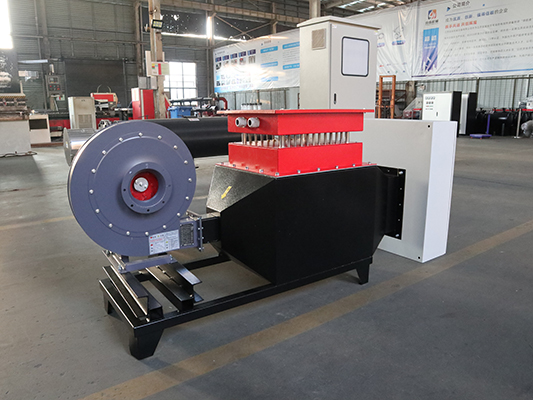Working principle
By converting electrical energy into thermal energy, and then transferring the thermal energy to the object that needs to be heated through an air duct. Steel plates are usually used to support electric heating tubes to reduce vibration when the fan stops, and an over temperature control device is installed in the junction box. In terms of control, in addition to installing over temperature protection, a connecting device is also installed between the fan and the heater to ensure that the electric heater starts after the fan starts. At the same time, a differential pressure device is added before and after the heater to prevent wind turbine failure.
Structural Design
Explosion proof enclosure: Made of explosion-proof materials such as high-quality steel plates or aluminum alloys, it can effectively prevent internal sparks, arcs, and other sparks from igniting external flammable and explosive gases or dust.
Heating element: Generally, resistance wires or heating elements are used, commonly including stainless steel electric heating tubes, which have good high temperature resistance and oxidation resistance, and can efficiently convert electrical energy into thermal energy.
Insulation layer: Medium temperature and high temperature explosion-proof air duct heaters are sandwiched with 100mm thick insulation material from the outer wall of the channel to the heater junction box, which reduces the external heat dissipation of the entire channel and lowers the temperature inside the junction box.
Temperature control system: equipped with temperature sensors and controllers, capable of real-time monitoring and control of heating temperature, ensuring the stability and safety of the heating process, and automatically adjusting the heating power according to the set temperature range.
Safety protection devices: including over temperature protectors, over-current protectors, fuses, etc. When the temperature exceeds the set value, the current is too high, or other abnormal situations occur, the power can be immediately cut off or other measures can be taken to protect the safety of equipment and personnel.
Characteristic
Superior explosion-proof performance: adopting special explosion-proof materials and structural design, effectively preventing sparks and explosions, and can be safely applied in flammable and explosive places such as petrochemicals, coal mines, oil fields, etc.
High heating efficiency: The air duct heat transfer method can quickly transfer heat energy to the object that needs to be heated, reducing energy loss and improving production efficiency.
Uniform heating: The design is reasonable, with low air resistance, which can evenly heat the air without high or low temperature dead corners, ensuring the heating effect.
Accurate temperature control: Users can adjust the temperature according to their needs, and the temperature control system can automatically monitor and control the heating temperature to meet different heating requirements.
Safe and reliable: In addition to explosion-proof design, it is also equipped with various safety protection devices to ensure the safe operation of the equipment in various abnormal situations and reduce the risk of accidents.
Easy installation and maintenance: The product design is simple, compact, and easy to install, while also having good maintainability, making it convenient for users to perform daily maintenance and upkeep, reducing repair costs and downtime.

Application area
Petrochemical industry: used to heat equipment such as storage tanks, pipelines, and reactors, increase the temperature of the medium, and promote chemical reactions, such as heating crude oil, chemical raw materials, etc.
Coal mining industry: can be used to heat mine ventilation systems, provide a safe and comfortable working environment for underground workers, and can also be used for situations such as de icing at wellheads.
Oilfield industry: used to heat oil wells, tubing, and tanks, improve the fluidity of crude oil, and facilitate the extraction, transportation, and storage of crude oil.
Pharmaceutical industry: used in pharmaceutical equipment, reaction vessels, drying equipment, etc., to heat drugs, raw materials, and solutions to ensure the safety and reliability of the drug production process.
Food and beverage industry: Heating processes for food, liquids, and solutions, such as baking, steaming, sterilization, etc.
Post time: Mar-18-2025




